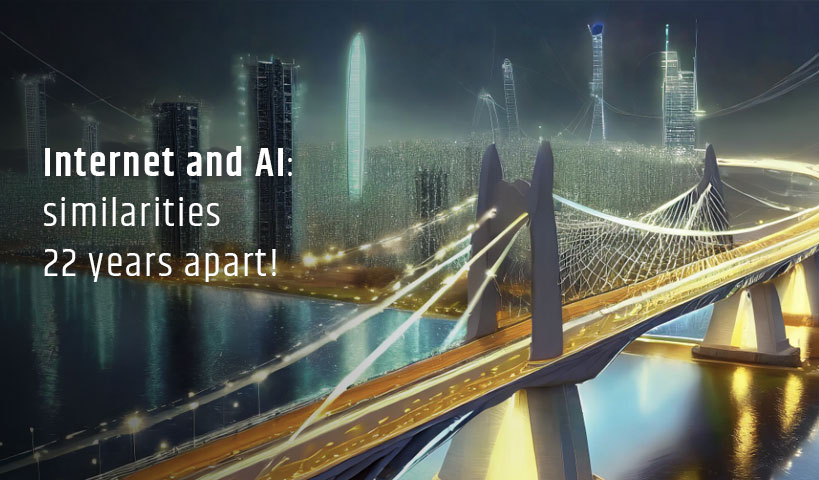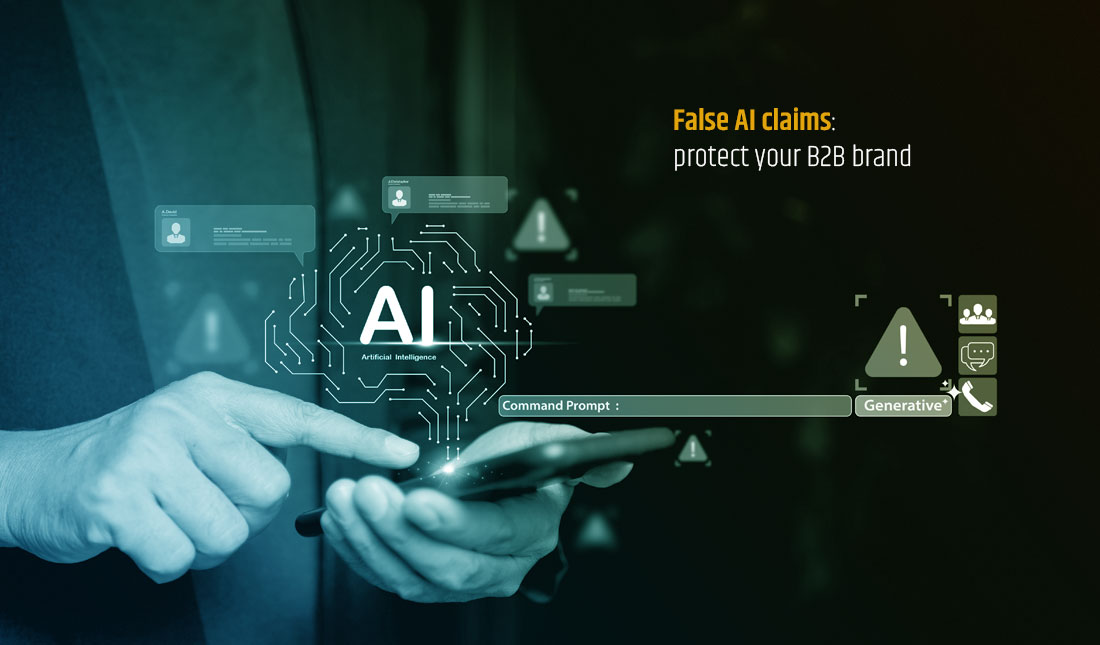
22 years ago, I wrote the first Exo article (the “B2B” was added the following year) entitled “Integrating the Internet into your business strategy”. Rereading it, I was struck by the similarities between the integration of the Internet into business and what we’re seeing now with the arrival of artificial intelligence.
In the first year of Exo’s creation, our goal was to integrate the Internet into companies’ business strategies, with a particular focus on marketing. At the time, Web or digital marketing, as we know it today, was not yet widespread. It was more commonly referred to as Internet or Web strategy.
It’s fair to say that there are similarities between the Internet of that era and what we’re experiencing today with the introduction of AI into business.
The adoption of the Internet at that time marked a revolution in the way companies worked and communicated. Today, AI presents itself as a new technological frontier, particularly in terms of transforming business practices. But also in terms of skills evolution, ethical concerns and repercussions on different industries. Both illustrate a tipping point towards a new era of innovation and digital transformation.
We’ll be coming back to these similarities in more detail in a LinkedIn post. Here is the 2002 article:

Image from waybackmachine
Integrating the Internet into your business strategy
Like the great revolutions that have brought about profound changes in the economy, information and communications technologies (ICT), particularly the Internet, have enabled businesses to work differently and more efficiently.
These transformations have had a direct and positive impact on productivity trends. “Between 1995 and 2000, the Internet and ICT are estimated to have boosted hourly output in the non-agricultural sector by 2.5% per year. This is not far from the record reached during the golden age from 1959 to 1973.”
The impact of Internet
The extent of the Internet’s impact on all levels of the organization was quickly realized. Productivity, financing, marketing, logistics, business processes and human resources management. Most observers agree that e-commerce reduces transaction costs. It improves resource allocation, enables economies of scale and increases the competitiveness of companies in general.
It’s only logical, then, that the advent of such far-reaching changes should shake up existing models and ways of doing things, and provoke numerous reactions. What’s more, previous technological revolutions have also been characterized by exaggeration and unrealistic business models.
The Internet was no exception. The bursting of the speculative bubble in Internet stocks came as no surprise. In this respect, excessive growth forecasts for e-commerce resulted in a data crisis and all that followed.
Many pioneers also neglected the preparation required for doing business with the Internet. Many underestimated the cost of getting consumers to change their habits. To create a new brand from scratch, or to master the complexities of a distribution network.
Today, it’s clear that the companies that have enjoyed the greatest advantage on the Internet are those that already have a brand. Or a business infrastructure, and who were able to integrate the Internet into their corporate strategy.
Governments, industries and customers take charge
The lack of reliable, internationally comparable data… This is what motivated the USA and other countries to integrate the measurement of electronic transactions into all their statistical programs. This exercise will make it possible to assess the impact of e-commerce on overall economic performance. In this way, decision-makers will be able to make judgements based on real data. And not on estimates that vary considerably from one private forecasting firm to another.
On the ground, the business world is now opting for a much more reasoned approach to the efforts that can be made to seize the opportunities presented by the Internet. In other words, it’s recognized that Internet business success is real, but not guaranteed.
This widespread customer attitude to the Internet is a driving force. It conditions the industry’s supply of Internet-related products and services. From now on, every Internet project must be treated as a business project. In other words, it must be approached from an investment perspective.
In fact, no Internet-related decision should be taken without a rational analysis of the market. Or the business potential of a project. What’s more, the most accurate possible estimate of the anticipated return on investment should not be overlooked.
Already, the Internet opportunity is confirmed and the industry is stabilizing. The new challenge for managers who want to succeed lies in choosing actions that create value. But also competitiveness and profitability. The experience of recent years has enabled us to situate these actions in two familiar universes. Marketing and operations.
Basic marketing rules apply to Internet business
It’s vital to have a clear idea of customers’ needs and what the company can offer. With profitability in mind, you need to choose the right products and services. But also the distribution channels to meet customer expectations. Precise objectives must also be set, so that results can be measured and corrective action taken if necessary. However, the Internet has its own rules that condition the application of known marketing practices.
For example, if you want to use your website as a communication tool, the concepts of brand image creation, positioning and differentiation still apply. We’re still concerned with communication strategy and graphic design, where creativity is called upon by customers.
However, things are done differently. Content is no longer treated in the same way. Graphic design now has to take into account the website’s usability. Last but not least, you need to offer at least a few value-added functionalities, compared with traditional communication methods. The Internet cannot be treated like any other communication channel.
For marketing managers who are prepared to commit resources and review their business processes, the Internet offers the opportunity to improve the way customers are served, while optimizing operational efficiency. The Internet can also speed up marketing processes. And bring highly satisfying results when actions are targeted.
Operational excellence and financial performance
Companies wishing to improve their financial performance can achieve very interesting results by taking concerted action on their operations. Internet technologies have a multitude of applications. They can have a significant effect on profit margins, asset turnover and return on equity.
However, managers must be prepared to review certain business processes. To mobilize their troops and take the time to choose applications. All the while keeping in mind the operational and human realities of their business.
Finally, those who are able to convince their partners and suppliers will achieve superior performance.
For the latter, performance will relate to the integration of information systems, the alignment of business processes and the willingness to share information with other companies. This is a complex and ambitious task. But such cooperation on the Internet opens up new possibilities for alliances to compete with other business networks.
SMEs and exports
For SMEs, the Internet offers new opportunities to participate in international trade. The Internet provides access to new suppliers and partners. It also gives SMEs the opportunity to implement new, less costly strategies for creating a brand image in markets to which they previously had little access.
When it comes to international trade, traditional marketing and export channels are dominated by numerous intermediaries. It can be difficult for a new entrant to break into these infrastructures. The Internet makes it possible to improve the situation through e-commerce.
But beware: a website may open a window on the world market, but it is no substitute for an export strategy adapted to the Internet. A good strategy must address financing, insurance, transport and market information needs.
ROI and strategic benefits
To ensure a return on investment, it’s important to define priority areas in which the company can expect rapid results. It is also important to exploit all the opportunities for operational efficiency and business development that apply to the Internet. To improve long-term competitiveness, companies need to take strategic benefits into account. These include improving customer satisfaction through better customer service. Or adding new products or services to a new distribution channel, or sharing knowledge between employees or partners.
In other words, those who will make the most of the Internet will be the companies that integrate it into their business strategy and adopt a reasoned approach to investment choices.
References
United Nations Conference on Electronic Commerce and Development, Report on Electronic Commerce and Development 2001, United Nations, New York and Geneva, 2001.
BARUA, Anitesh, PRABHUDEV, Konana, WHINSTON, Andrew B., and YIN, Fang, Driving E-Business Excellence, MIT Sloan Management Review, Cambridge, Fall, 2001, pp.36-44.




